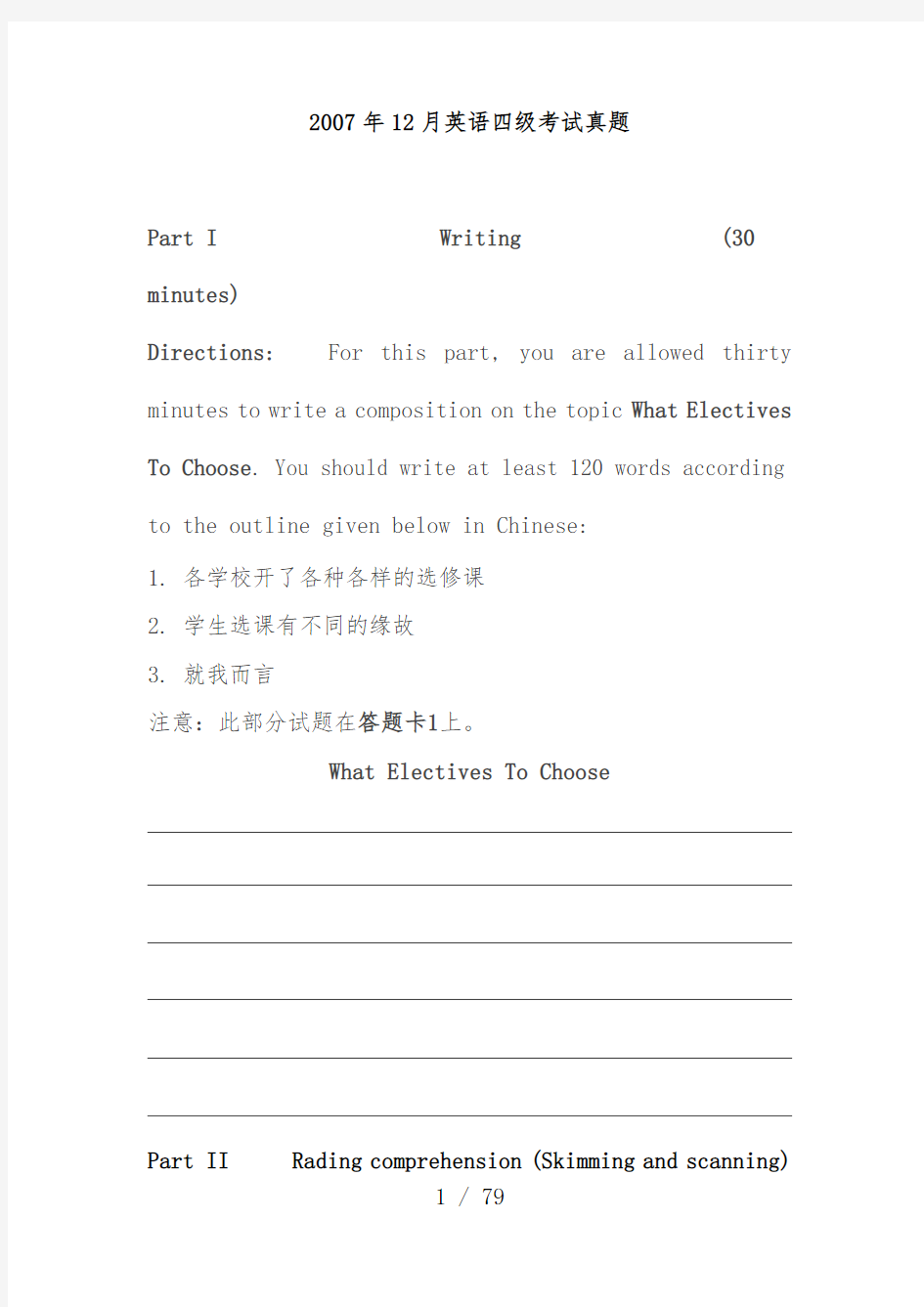英语四级年度考试真题与标准答案分析

- 1、下载文档前请自行甄别文档内容的完整性,平台不提供额外的编辑、内容补充、找答案等附加服务。
- 2、"仅部分预览"的文档,不可在线预览部分如存在完整性等问题,可反馈申请退款(可完整预览的文档不适用该条件!)。
- 3、如文档侵犯您的权益,请联系客服反馈,我们会尽快为您处理(人工客服工作时间:9:00-18:30)。
2007年12月英语四级考试真题
Part I Writing (30 minutes)
Directions: For this part, you are allowed thirty minutes to write a composition on the topic What Electives
To Choose. You should write at least 120 words according
to the outline given below in Chinese:
1. 各学校开了各种各样的选修课
2. 学生选课有不同的缘故
3. 就我而言
注意:此部分试题在答题卡1上。
What Electives To Choose
Part II Rading comprehension (Skimming and scanning)
(15minutes)
Directions: In this part, you will have 15 minutes to go over the passsage quickly and answer the
questions on Answer Sheet 1. For questions 1-7,
choose the best answer from the four choices
marked A), B),C) and D). For questions 8-10,
complete the sentences with the information given
in the passage.
Univeraities Branch Out
As never before in their long story, universities have become instruments of national
competition as well as instruments of peace. They are the place of the scientific discoveries that move economies forward, and the primary means of educating the talent required to obtain and
maintain competitive advantages. But at the same time, the opening of national borders to the flow
of goods, services, information and especially people has made universities a powerful force for
global integration, mutual understanding and geopolitical stability.
In response to the same forces that have driven the world economy, universities have become
More self-consciousy global: seeking students from around the world who represent the entire
range of cultures and values, sending their own students abroad to prepare them for global careers, offering courses of study that address the challenges of an interconnected world and collaborative (合作的)research programs to advance science for the benefit of all humanity.
Of the forces shaping higher education none is more sweeping than the movement across borders. Over the past three decades the number of students leaving home each year to study abroad has grown at an annual rate of 3.0 percent, from 8000,000 in 1975 to 2.5 million in 2994. Most travel from one developed nation to another, but the flow from developing to developed countries id growing rapidly. The
reverse flow, from developed to developing countries, is on the rise, too. Today foreign students earn 30 percent of the doctoral degrees awarded in the United States and 38 percent of those in the United Kingdom. And the number crossing borders for undergraduate study is growing as well, to 8 percent of the undergraduates at America’s best institutions and 10 percent of all undergraduates in the U.K. In the United States, 20 percent of the newly hired professors in science and engineering are foreign-born, and in China many newly hired faculty hired faculty members at the top research universities received their graduate education abroad.
Universities are also encouraging students to spend some of their undergraduate years in another country. In Europe, more than 140,000 students participate in the Erasmus program each year, taking courses for credit in one of 2, 2000 participating institutions across the continent. And in the United States, institutions are helping place students in summer internships(实习)abroad to prepare them
